Introduction to Health and Social Care: Lambeth Analysis Report
VerifiedAdded on 2020/02/05
|11
|4332
|140
Report
AI Summary
This report provides an introduction to health and social care, focusing on the London Borough of Lambeth and the issue of HIV. It begins by examining the social determinants of health, including economic stability, education, and community context, and their relationship to health inequalities. The report then analyzes current health and social care policies in Lambeth, highlighting initiatives to improve sexual health, address inequalities, and provide support to those living with HIV. Finally, it explores contemporary public health provisions aimed at addressing health inequalities in the area, including modern strategies to deliver healthcare services. The report emphasizes the importance of awareness, access to care, and the implementation of effective policies to improve health outcomes for all residents. The report also highlights the various health and social care organizations that are working to improve the health of the people in the community.
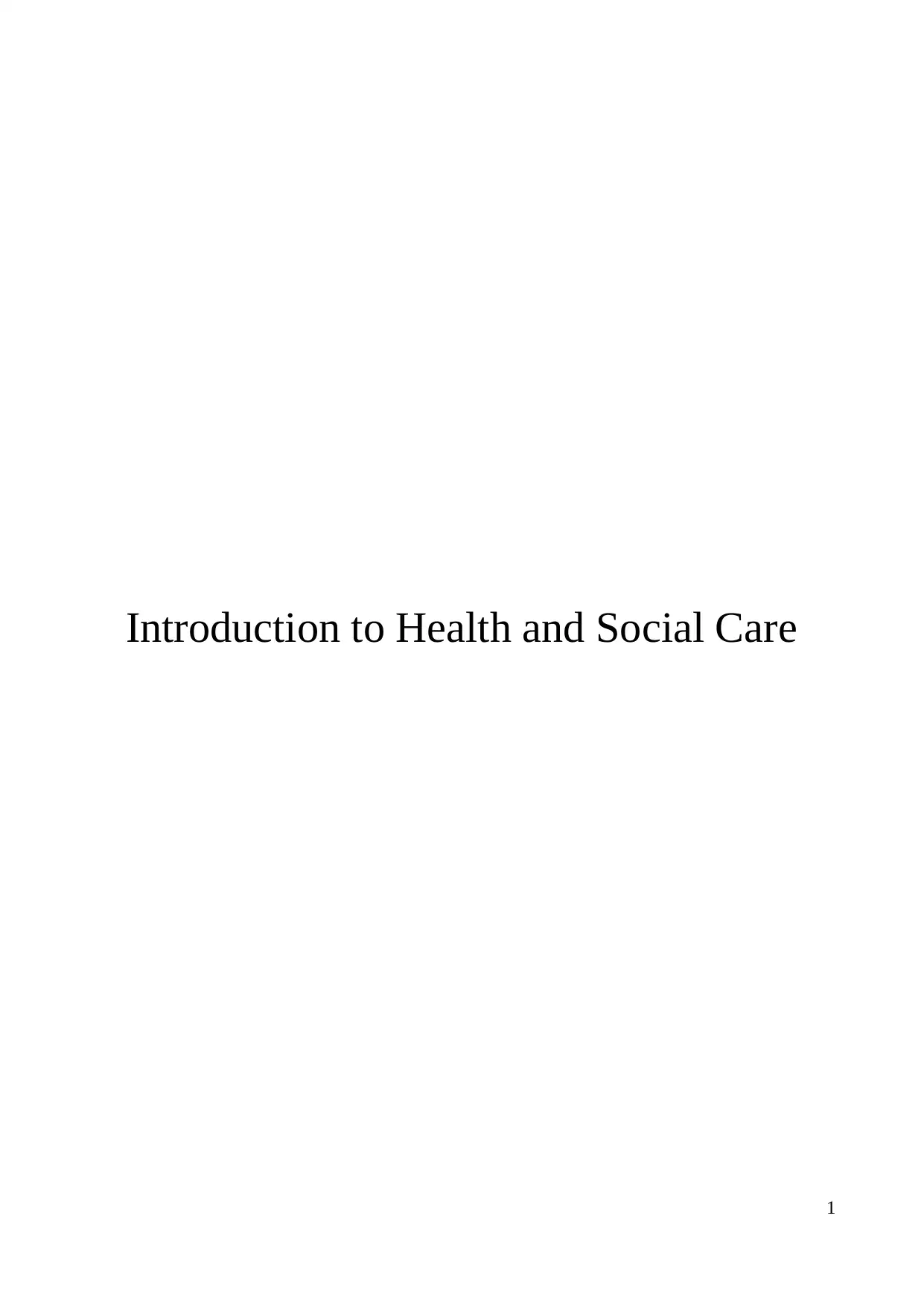
Introduction to Health and Social Care
1
1
Paraphrase This Document
Need a fresh take? Get an instant paraphrase of this document with our AI Paraphraser

Table of Contents
INTRODUCTION ...............................................................................................................................3
TASK....................................................................................................................................................3
1. Social determinants of health and its relation to health inequalities............................................3
2. Current health and social care policies and their application on London Borough of Lambeth 5
3. Contemporary public health provision in the London Borough of Lambeth which aims to
address inequalities in health...........................................................................................................7
CONCLUSION ...................................................................................................................................9
References..........................................................................................................................................10
2
INTRODUCTION ...............................................................................................................................3
TASK....................................................................................................................................................3
1. Social determinants of health and its relation to health inequalities............................................3
2. Current health and social care policies and their application on London Borough of Lambeth 5
3. Contemporary public health provision in the London Borough of Lambeth which aims to
address inequalities in health...........................................................................................................7
CONCLUSION ...................................................................................................................................9
References..........................................................................................................................................10
2
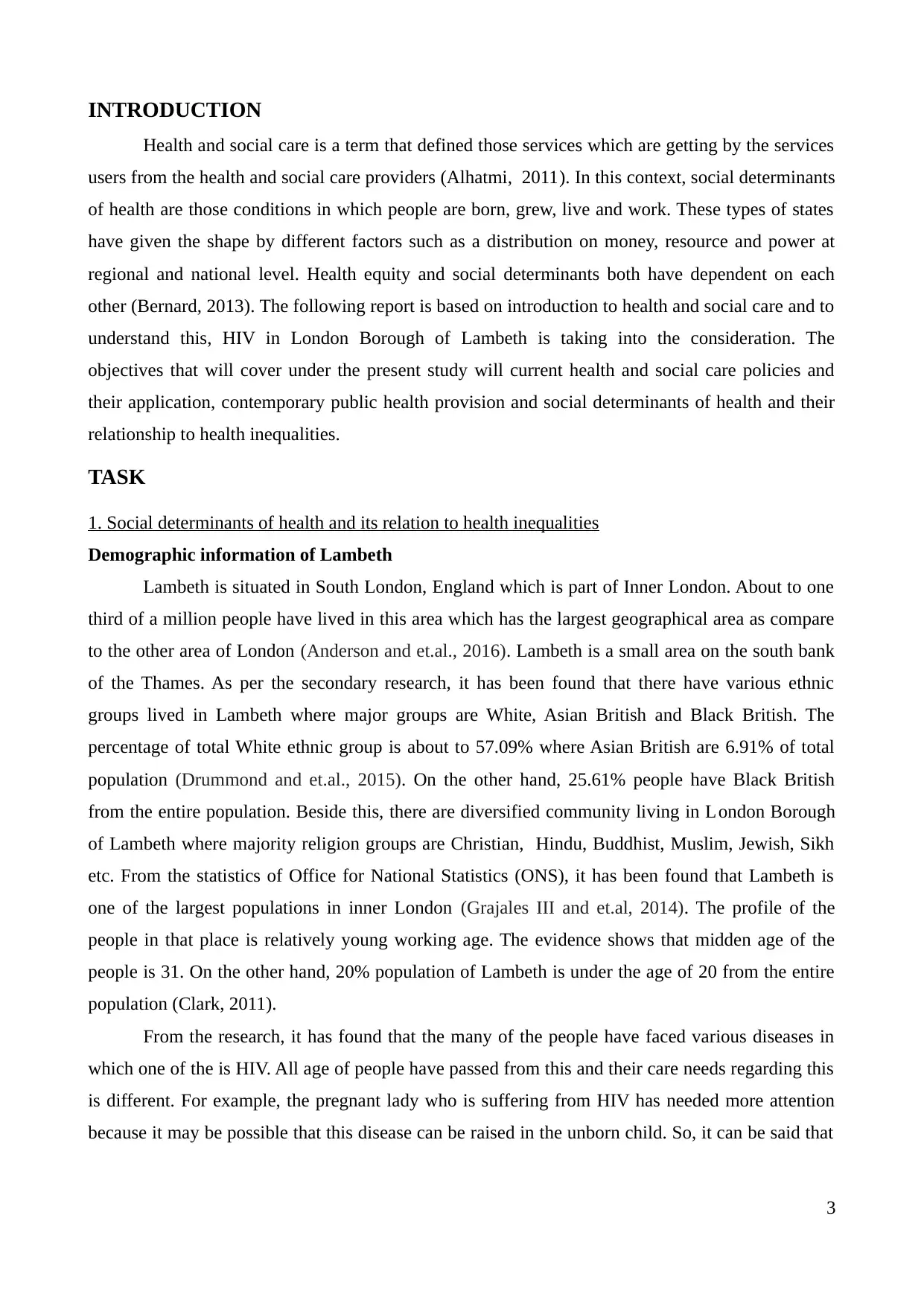
INTRODUCTION
Health and social care is a term that defined those services which are getting by the services
users from the health and social care providers (Alhatmi, 2011). In this context, social determinants
of health are those conditions in which people are born, grew, live and work. These types of states
have given the shape by different factors such as a distribution on money, resource and power at
regional and national level. Health equity and social determinants both have dependent on each
other (Bernard, 2013). The following report is based on introduction to health and social care and to
understand this, HIV in London Borough of Lambeth is taking into the consideration. The
objectives that will cover under the present study will current health and social care policies and
their application, contemporary public health provision and social determinants of health and their
relationship to health inequalities.
TASK
1. Social determinants of health and its relation to health inequalities
Demographic information of Lambeth
Lambeth is situated in South London, England which is part of Inner London. About to one
third of a million people have lived in this area which has the largest geographical area as compare
to the other area of London (Anderson and et.al., 2016). Lambeth is a small area on the south bank
of the Thames. As per the secondary research, it has been found that there have various ethnic
groups lived in Lambeth where major groups are White, Asian British and Black British. The
percentage of total White ethnic group is about to 57.09% where Asian British are 6.91% of total
population (Drummond and et.al., 2015). On the other hand, 25.61% people have Black British
from the entire population. Beside this, there are diversified community living in London Borough
of Lambeth where majority religion groups are Christian, Hindu, Buddhist, Muslim, Jewish, Sikh
etc. From the statistics of Office for National Statistics (ONS), it has been found that Lambeth is
one of the largest populations in inner London (Grajales III and et.al, 2014). The profile of the
people in that place is relatively young working age. The evidence shows that midden age of the
people is 31. On the other hand, 20% population of Lambeth is under the age of 20 from the entire
population (Clark, 2011).
From the research, it has found that the many of the people have faced various diseases in
which one of the is HIV. All age of people have passed from this and their care needs regarding this
is different. For example, the pregnant lady who is suffering from HIV has needed more attention
because it may be possible that this disease can be raised in the unborn child. So, it can be said that
3
Health and social care is a term that defined those services which are getting by the services
users from the health and social care providers (Alhatmi, 2011). In this context, social determinants
of health are those conditions in which people are born, grew, live and work. These types of states
have given the shape by different factors such as a distribution on money, resource and power at
regional and national level. Health equity and social determinants both have dependent on each
other (Bernard, 2013). The following report is based on introduction to health and social care and to
understand this, HIV in London Borough of Lambeth is taking into the consideration. The
objectives that will cover under the present study will current health and social care policies and
their application, contemporary public health provision and social determinants of health and their
relationship to health inequalities.
TASK
1. Social determinants of health and its relation to health inequalities
Demographic information of Lambeth
Lambeth is situated in South London, England which is part of Inner London. About to one
third of a million people have lived in this area which has the largest geographical area as compare
to the other area of London (Anderson and et.al., 2016). Lambeth is a small area on the south bank
of the Thames. As per the secondary research, it has been found that there have various ethnic
groups lived in Lambeth where major groups are White, Asian British and Black British. The
percentage of total White ethnic group is about to 57.09% where Asian British are 6.91% of total
population (Drummond and et.al., 2015). On the other hand, 25.61% people have Black British
from the entire population. Beside this, there are diversified community living in London Borough
of Lambeth where majority religion groups are Christian, Hindu, Buddhist, Muslim, Jewish, Sikh
etc. From the statistics of Office for National Statistics (ONS), it has been found that Lambeth is
one of the largest populations in inner London (Grajales III and et.al, 2014). The profile of the
people in that place is relatively young working age. The evidence shows that midden age of the
people is 31. On the other hand, 20% population of Lambeth is under the age of 20 from the entire
population (Clark, 2011).
From the research, it has found that the many of the people have faced various diseases in
which one of the is HIV. All age of people have passed from this and their care needs regarding this
is different. For example, the pregnant lady who is suffering from HIV has needed more attention
because it may be possible that this disease can be raised in the unborn child. So, it can be said that
3
⊘ This is a preview!⊘
Do you want full access?
Subscribe today to unlock all pages.

Trusted by 1+ million students worldwide
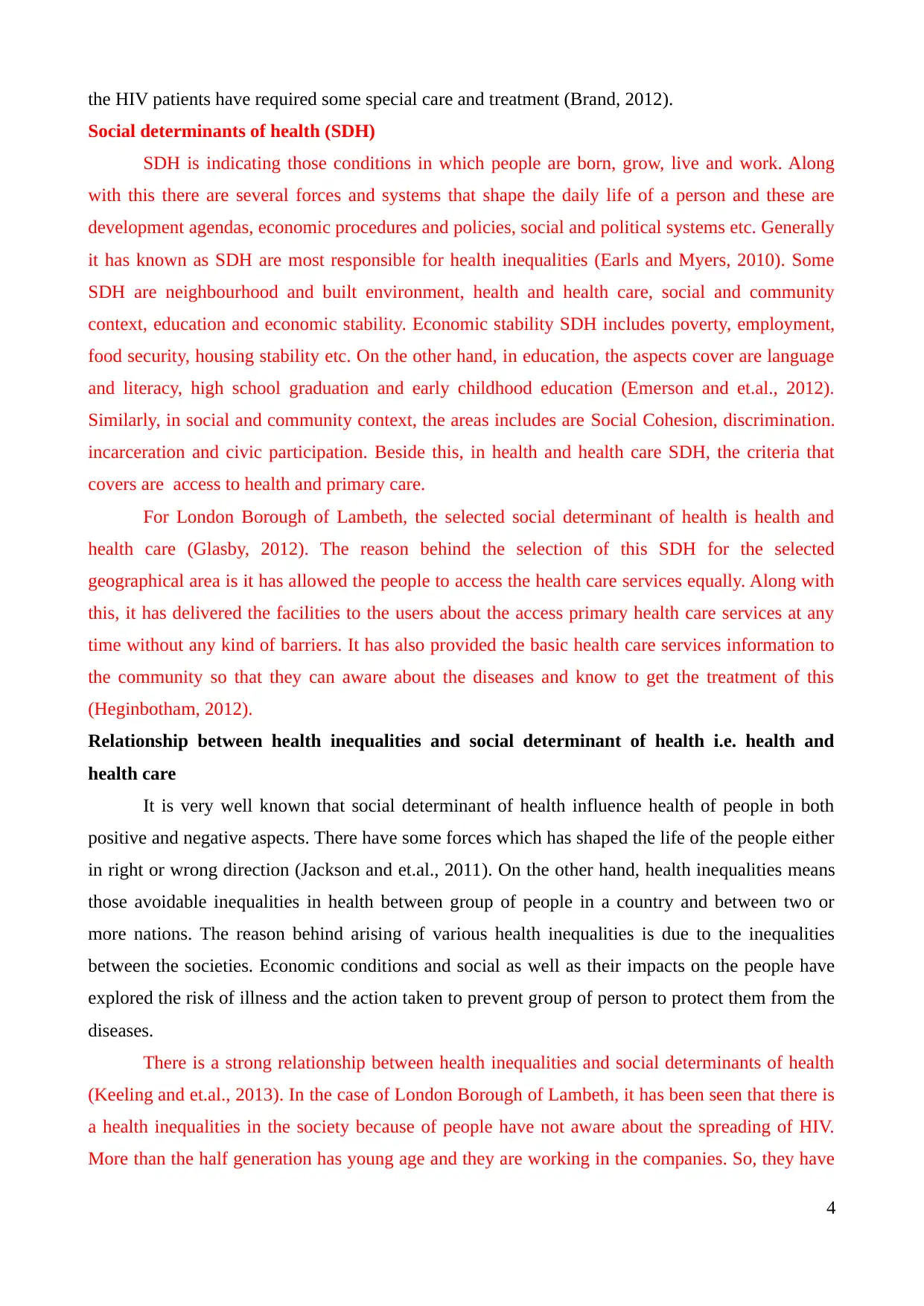
the HIV patients have required some special care and treatment (Brand, 2012).
Social determinants of health (SDH)
SDH is indicating those conditions in which people are born, grow, live and work. Along
with this there are several forces and systems that shape the daily life of a person and these are
development agendas, economic procedures and policies, social and political systems etc. Generally
it has known as SDH are most responsible for health inequalities (Earls and Myers, 2010). Some
SDH are neighbourhood and built environment, health and health care, social and community
context, education and economic stability. Economic stability SDH includes poverty, employment,
food security, housing stability etc. On the other hand, in education, the aspects cover are language
and literacy, high school graduation and early childhood education (Emerson and et.al., 2012).
Similarly, in social and community context, the areas includes are Social Cohesion, discrimination.
incarceration and civic participation. Beside this, in health and health care SDH, the criteria that
covers are access to health and primary care.
For London Borough of Lambeth, the selected social determinant of health is health and
health care (Glasby, 2012). The reason behind the selection of this SDH for the selected
geographical area is it has allowed the people to access the health care services equally. Along with
this, it has delivered the facilities to the users about the access primary health care services at any
time without any kind of barriers. It has also provided the basic health care services information to
the community so that they can aware about the diseases and know to get the treatment of this
(Heginbotham, 2012).
Relationship between health inequalities and social determinant of health i.e. health and
health care
It is very well known that social determinant of health influence health of people in both
positive and negative aspects. There have some forces which has shaped the life of the people either
in right or wrong direction (Jackson and et.al., 2011). On the other hand, health inequalities means
those avoidable inequalities in health between group of people in a country and between two or
more nations. The reason behind arising of various health inequalities is due to the inequalities
between the societies. Economic conditions and social as well as their impacts on the people have
explored the risk of illness and the action taken to prevent group of person to protect them from the
diseases.
There is a strong relationship between health inequalities and social determinants of health
(Keeling and et.al., 2013). In the case of London Borough of Lambeth, it has been seen that there is
a health inequalities in the society because of people have not aware about the spreading of HIV.
More than the half generation has young age and they are working in the companies. So, they have
4
Social determinants of health (SDH)
SDH is indicating those conditions in which people are born, grow, live and work. Along
with this there are several forces and systems that shape the daily life of a person and these are
development agendas, economic procedures and policies, social and political systems etc. Generally
it has known as SDH are most responsible for health inequalities (Earls and Myers, 2010). Some
SDH are neighbourhood and built environment, health and health care, social and community
context, education and economic stability. Economic stability SDH includes poverty, employment,
food security, housing stability etc. On the other hand, in education, the aspects cover are language
and literacy, high school graduation and early childhood education (Emerson and et.al., 2012).
Similarly, in social and community context, the areas includes are Social Cohesion, discrimination.
incarceration and civic participation. Beside this, in health and health care SDH, the criteria that
covers are access to health and primary care.
For London Borough of Lambeth, the selected social determinant of health is health and
health care (Glasby, 2012). The reason behind the selection of this SDH for the selected
geographical area is it has allowed the people to access the health care services equally. Along with
this, it has delivered the facilities to the users about the access primary health care services at any
time without any kind of barriers. It has also provided the basic health care services information to
the community so that they can aware about the diseases and know to get the treatment of this
(Heginbotham, 2012).
Relationship between health inequalities and social determinant of health i.e. health and
health care
It is very well known that social determinant of health influence health of people in both
positive and negative aspects. There have some forces which has shaped the life of the people either
in right or wrong direction (Jackson and et.al., 2011). On the other hand, health inequalities means
those avoidable inequalities in health between group of people in a country and between two or
more nations. The reason behind arising of various health inequalities is due to the inequalities
between the societies. Economic conditions and social as well as their impacts on the people have
explored the risk of illness and the action taken to prevent group of person to protect them from the
diseases.
There is a strong relationship between health inequalities and social determinants of health
(Keeling and et.al., 2013). In the case of London Borough of Lambeth, it has been seen that there is
a health inequalities in the society because of people have not aware about the spreading of HIV.
More than the half generation has young age and they are working in the companies. So, they have
4
Paraphrase This Document
Need a fresh take? Get an instant paraphrase of this document with our AI Paraphraser
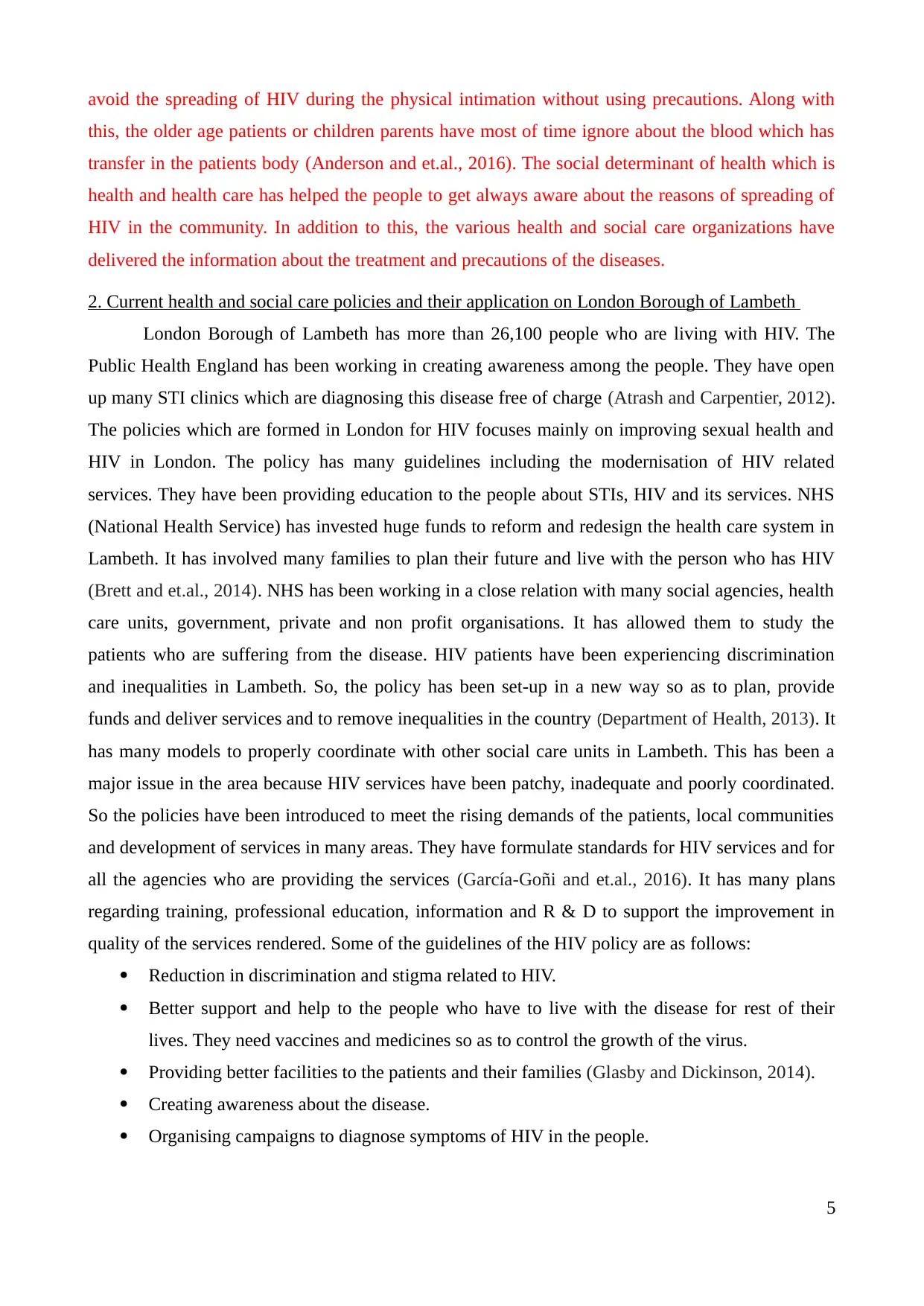
avoid the spreading of HIV during the physical intimation without using precautions. Along with
this, the older age patients or children parents have most of time ignore about the blood which has
transfer in the patients body (Anderson and et.al., 2016). The social determinant of health which is
health and health care has helped the people to get always aware about the reasons of spreading of
HIV in the community. In addition to this, the various health and social care organizations have
delivered the information about the treatment and precautions of the diseases.
2. Current health and social care policies and their application on London Borough of Lambeth
London Borough of Lambeth has more than 26,100 people who are living with HIV. The
Public Health England has been working in creating awareness among the people. They have open
up many STI clinics which are diagnosing this disease free of charge (Atrash and Carpentier, 2012).
The policies which are formed in London for HIV focuses mainly on improving sexual health and
HIV in London. The policy has many guidelines including the modernisation of HIV related
services. They have been providing education to the people about STIs, HIV and its services. NHS
(National Health Service) has invested huge funds to reform and redesign the health care system in
Lambeth. It has involved many families to plan their future and live with the person who has HIV
(Brett and et.al., 2014). NHS has been working in a close relation with many social agencies, health
care units, government, private and non profit organisations. It has allowed them to study the
patients who are suffering from the disease. HIV patients have been experiencing discrimination
and inequalities in Lambeth. So, the policy has been set-up in a new way so as to plan, provide
funds and deliver services and to remove inequalities in the country (Department of Health, 2013). It
has many models to properly coordinate with other social care units in Lambeth. This has been a
major issue in the area because HIV services have been patchy, inadequate and poorly coordinated.
So the policies have been introduced to meet the rising demands of the patients, local communities
and development of services in many areas. They have formulate standards for HIV services and for
all the agencies who are providing the services (García-Goñi and et.al., 2016). It has many plans
regarding training, professional education, information and R & D to support the improvement in
quality of the services rendered. Some of the guidelines of the HIV policy are as follows:
Reduction in discrimination and stigma related to HIV.
Better support and help to the people who have to live with the disease for rest of their
lives. They need vaccines and medicines so as to control the growth of the virus.
Providing better facilities to the patients and their families (Glasby and Dickinson, 2014).
Creating awareness about the disease.
Organising campaigns to diagnose symptoms of HIV in the people.
5
this, the older age patients or children parents have most of time ignore about the blood which has
transfer in the patients body (Anderson and et.al., 2016). The social determinant of health which is
health and health care has helped the people to get always aware about the reasons of spreading of
HIV in the community. In addition to this, the various health and social care organizations have
delivered the information about the treatment and precautions of the diseases.
2. Current health and social care policies and their application on London Borough of Lambeth
London Borough of Lambeth has more than 26,100 people who are living with HIV. The
Public Health England has been working in creating awareness among the people. They have open
up many STI clinics which are diagnosing this disease free of charge (Atrash and Carpentier, 2012).
The policies which are formed in London for HIV focuses mainly on improving sexual health and
HIV in London. The policy has many guidelines including the modernisation of HIV related
services. They have been providing education to the people about STIs, HIV and its services. NHS
(National Health Service) has invested huge funds to reform and redesign the health care system in
Lambeth. It has involved many families to plan their future and live with the person who has HIV
(Brett and et.al., 2014). NHS has been working in a close relation with many social agencies, health
care units, government, private and non profit organisations. It has allowed them to study the
patients who are suffering from the disease. HIV patients have been experiencing discrimination
and inequalities in Lambeth. So, the policy has been set-up in a new way so as to plan, provide
funds and deliver services and to remove inequalities in the country (Department of Health, 2013). It
has many models to properly coordinate with other social care units in Lambeth. This has been a
major issue in the area because HIV services have been patchy, inadequate and poorly coordinated.
So the policies have been introduced to meet the rising demands of the patients, local communities
and development of services in many areas. They have formulate standards for HIV services and for
all the agencies who are providing the services (García-Goñi and et.al., 2016). It has many plans
regarding training, professional education, information and R & D to support the improvement in
quality of the services rendered. Some of the guidelines of the HIV policy are as follows:
Reduction in discrimination and stigma related to HIV.
Better support and help to the people who have to live with the disease for rest of their
lives. They need vaccines and medicines so as to control the growth of the virus.
Providing better facilities to the patients and their families (Glasby and Dickinson, 2014).
Creating awareness about the disease.
Organising campaigns to diagnose symptoms of HIV in the people.
5
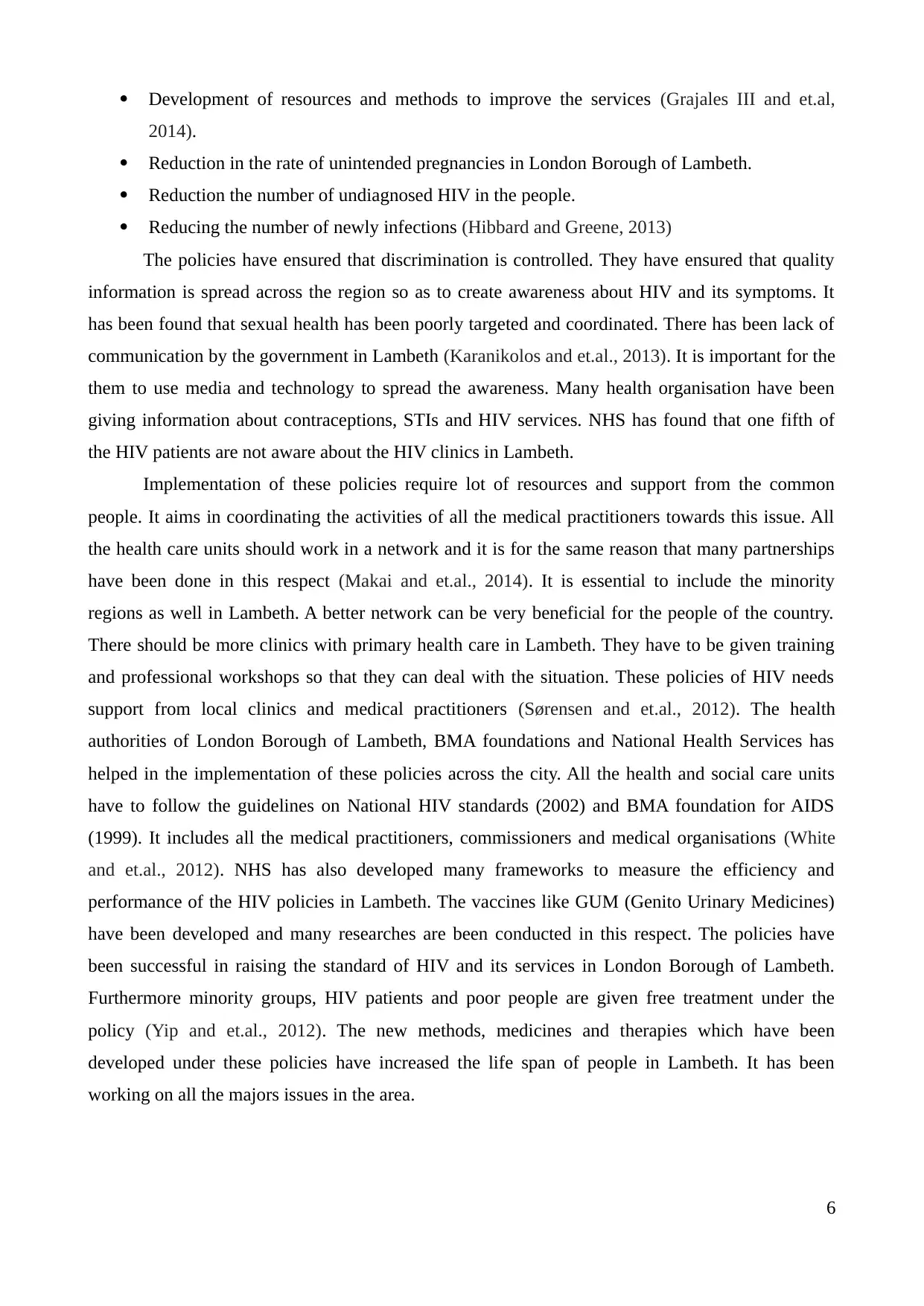
Development of resources and methods to improve the services (Grajales III and et.al,
2014).
Reduction in the rate of unintended pregnancies in London Borough of Lambeth.
Reduction the number of undiagnosed HIV in the people.
Reducing the number of newly infections (Hibbard and Greene, 2013)
The policies have ensured that discrimination is controlled. They have ensured that quality
information is spread across the region so as to create awareness about HIV and its symptoms. It
has been found that sexual health has been poorly targeted and coordinated. There has been lack of
communication by the government in Lambeth (Karanikolos and et.al., 2013). It is important for the
them to use media and technology to spread the awareness. Many health organisation have been
giving information about contraceptions, STIs and HIV services. NHS has found that one fifth of
the HIV patients are not aware about the HIV clinics in Lambeth.
Implementation of these policies require lot of resources and support from the common
people. It aims in coordinating the activities of all the medical practitioners towards this issue. All
the health care units should work in a network and it is for the same reason that many partnerships
have been done in this respect (Makai and et.al., 2014). It is essential to include the minority
regions as well in Lambeth. A better network can be very beneficial for the people of the country.
There should be more clinics with primary health care in Lambeth. They have to be given training
and professional workshops so that they can deal with the situation. These policies of HIV needs
support from local clinics and medical practitioners (Sørensen and et.al., 2012). The health
authorities of London Borough of Lambeth, BMA foundations and National Health Services has
helped in the implementation of these policies across the city. All the health and social care units
have to follow the guidelines on National HIV standards (2002) and BMA foundation for AIDS
(1999). It includes all the medical practitioners, commissioners and medical organisations (White
and et.al., 2012). NHS has also developed many frameworks to measure the efficiency and
performance of the HIV policies in Lambeth. The vaccines like GUM (Genito Urinary Medicines)
have been developed and many researches are been conducted in this respect. The policies have
been successful in raising the standard of HIV and its services in London Borough of Lambeth.
Furthermore minority groups, HIV patients and poor people are given free treatment under the
policy (Yip and et.al., 2012). The new methods, medicines and therapies which have been
developed under these policies have increased the life span of people in Lambeth. It has been
working on all the majors issues in the area.
6
2014).
Reduction in the rate of unintended pregnancies in London Borough of Lambeth.
Reduction the number of undiagnosed HIV in the people.
Reducing the number of newly infections (Hibbard and Greene, 2013)
The policies have ensured that discrimination is controlled. They have ensured that quality
information is spread across the region so as to create awareness about HIV and its symptoms. It
has been found that sexual health has been poorly targeted and coordinated. There has been lack of
communication by the government in Lambeth (Karanikolos and et.al., 2013). It is important for the
them to use media and technology to spread the awareness. Many health organisation have been
giving information about contraceptions, STIs and HIV services. NHS has found that one fifth of
the HIV patients are not aware about the HIV clinics in Lambeth.
Implementation of these policies require lot of resources and support from the common
people. It aims in coordinating the activities of all the medical practitioners towards this issue. All
the health care units should work in a network and it is for the same reason that many partnerships
have been done in this respect (Makai and et.al., 2014). It is essential to include the minority
regions as well in Lambeth. A better network can be very beneficial for the people of the country.
There should be more clinics with primary health care in Lambeth. They have to be given training
and professional workshops so that they can deal with the situation. These policies of HIV needs
support from local clinics and medical practitioners (Sørensen and et.al., 2012). The health
authorities of London Borough of Lambeth, BMA foundations and National Health Services has
helped in the implementation of these policies across the city. All the health and social care units
have to follow the guidelines on National HIV standards (2002) and BMA foundation for AIDS
(1999). It includes all the medical practitioners, commissioners and medical organisations (White
and et.al., 2012). NHS has also developed many frameworks to measure the efficiency and
performance of the HIV policies in Lambeth. The vaccines like GUM (Genito Urinary Medicines)
have been developed and many researches are been conducted in this respect. The policies have
been successful in raising the standard of HIV and its services in London Borough of Lambeth.
Furthermore minority groups, HIV patients and poor people are given free treatment under the
policy (Yip and et.al., 2012). The new methods, medicines and therapies which have been
developed under these policies have increased the life span of people in Lambeth. It has been
working on all the majors issues in the area.
6
⊘ This is a preview!⊘
Do you want full access?
Subscribe today to unlock all pages.

Trusted by 1+ million students worldwide
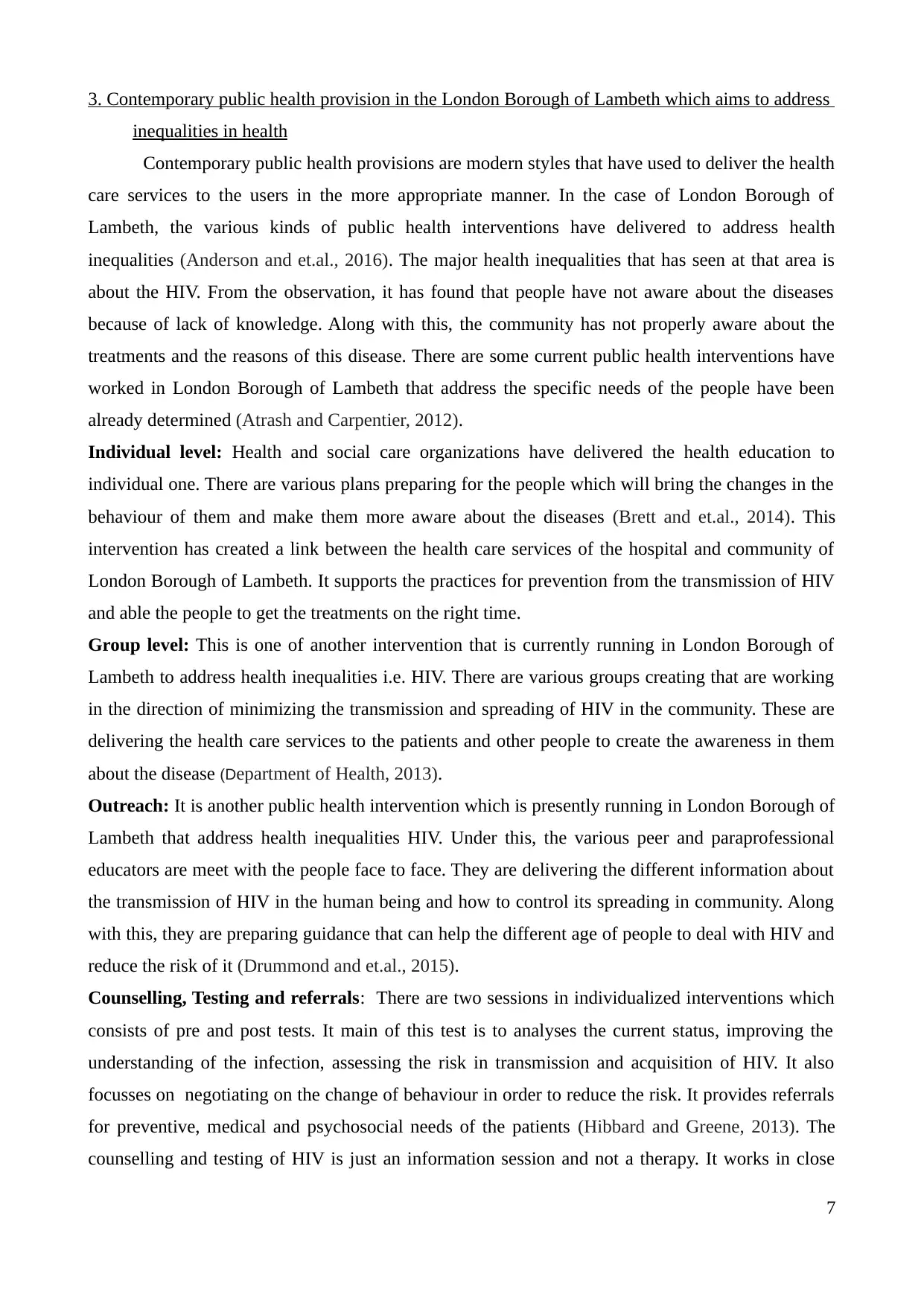
3. Contemporary public health provision in the London Borough of Lambeth which aims to address
inequalities in health
Contemporary public health provisions are modern styles that have used to deliver the health
care services to the users in the more appropriate manner. In the case of London Borough of
Lambeth, the various kinds of public health interventions have delivered to address health
inequalities (Anderson and et.al., 2016). The major health inequalities that has seen at that area is
about the HIV. From the observation, it has found that people have not aware about the diseases
because of lack of knowledge. Along with this, the community has not properly aware about the
treatments and the reasons of this disease. There are some current public health interventions have
worked in London Borough of Lambeth that address the specific needs of the people have been
already determined (Atrash and Carpentier, 2012).
Individual level: Health and social care organizations have delivered the health education to
individual one. There are various plans preparing for the people which will bring the changes in the
behaviour of them and make them more aware about the diseases (Brett and et.al., 2014). This
intervention has created a link between the health care services of the hospital and community of
London Borough of Lambeth. It supports the practices for prevention from the transmission of HIV
and able the people to get the treatments on the right time.
Group level: This is one of another intervention that is currently running in London Borough of
Lambeth to address health inequalities i.e. HIV. There are various groups creating that are working
in the direction of minimizing the transmission and spreading of HIV in the community. These are
delivering the health care services to the patients and other people to create the awareness in them
about the disease (Department of Health, 2013).
Outreach: It is another public health intervention which is presently running in London Borough of
Lambeth that address health inequalities HIV. Under this, the various peer and paraprofessional
educators are meet with the people face to face. They are delivering the different information about
the transmission of HIV in the human being and how to control its spreading in community. Along
with this, they are preparing guidance that can help the different age of people to deal with HIV and
reduce the risk of it (Drummond and et.al., 2015).
Counselling, Testing and referrals: There are two sessions in individualized interventions which
consists of pre and post tests. It main of this test is to analyses the current status, improving the
understanding of the infection, assessing the risk in transmission and acquisition of HIV. It also
focusses on negotiating on the change of behaviour in order to reduce the risk. It provides referrals
for preventive, medical and psychosocial needs of the patients (Hibbard and Greene, 2013). The
counselling and testing of HIV is just an information session and not a therapy. It works in close
7
inequalities in health
Contemporary public health provisions are modern styles that have used to deliver the health
care services to the users in the more appropriate manner. In the case of London Borough of
Lambeth, the various kinds of public health interventions have delivered to address health
inequalities (Anderson and et.al., 2016). The major health inequalities that has seen at that area is
about the HIV. From the observation, it has found that people have not aware about the diseases
because of lack of knowledge. Along with this, the community has not properly aware about the
treatments and the reasons of this disease. There are some current public health interventions have
worked in London Borough of Lambeth that address the specific needs of the people have been
already determined (Atrash and Carpentier, 2012).
Individual level: Health and social care organizations have delivered the health education to
individual one. There are various plans preparing for the people which will bring the changes in the
behaviour of them and make them more aware about the diseases (Brett and et.al., 2014). This
intervention has created a link between the health care services of the hospital and community of
London Borough of Lambeth. It supports the practices for prevention from the transmission of HIV
and able the people to get the treatments on the right time.
Group level: This is one of another intervention that is currently running in London Borough of
Lambeth to address health inequalities i.e. HIV. There are various groups creating that are working
in the direction of minimizing the transmission and spreading of HIV in the community. These are
delivering the health care services to the patients and other people to create the awareness in them
about the disease (Department of Health, 2013).
Outreach: It is another public health intervention which is presently running in London Borough of
Lambeth that address health inequalities HIV. Under this, the various peer and paraprofessional
educators are meet with the people face to face. They are delivering the different information about
the transmission of HIV in the human being and how to control its spreading in community. Along
with this, they are preparing guidance that can help the different age of people to deal with HIV and
reduce the risk of it (Drummond and et.al., 2015).
Counselling, Testing and referrals: There are two sessions in individualized interventions which
consists of pre and post tests. It main of this test is to analyses the current status, improving the
understanding of the infection, assessing the risk in transmission and acquisition of HIV. It also
focusses on negotiating on the change of behaviour in order to reduce the risk. It provides referrals
for preventive, medical and psychosocial needs of the patients (Hibbard and Greene, 2013). The
counselling and testing of HIV is just an information session and not a therapy. It works in close
7
Paraphrase This Document
Need a fresh take? Get an instant paraphrase of this document with our AI Paraphraser
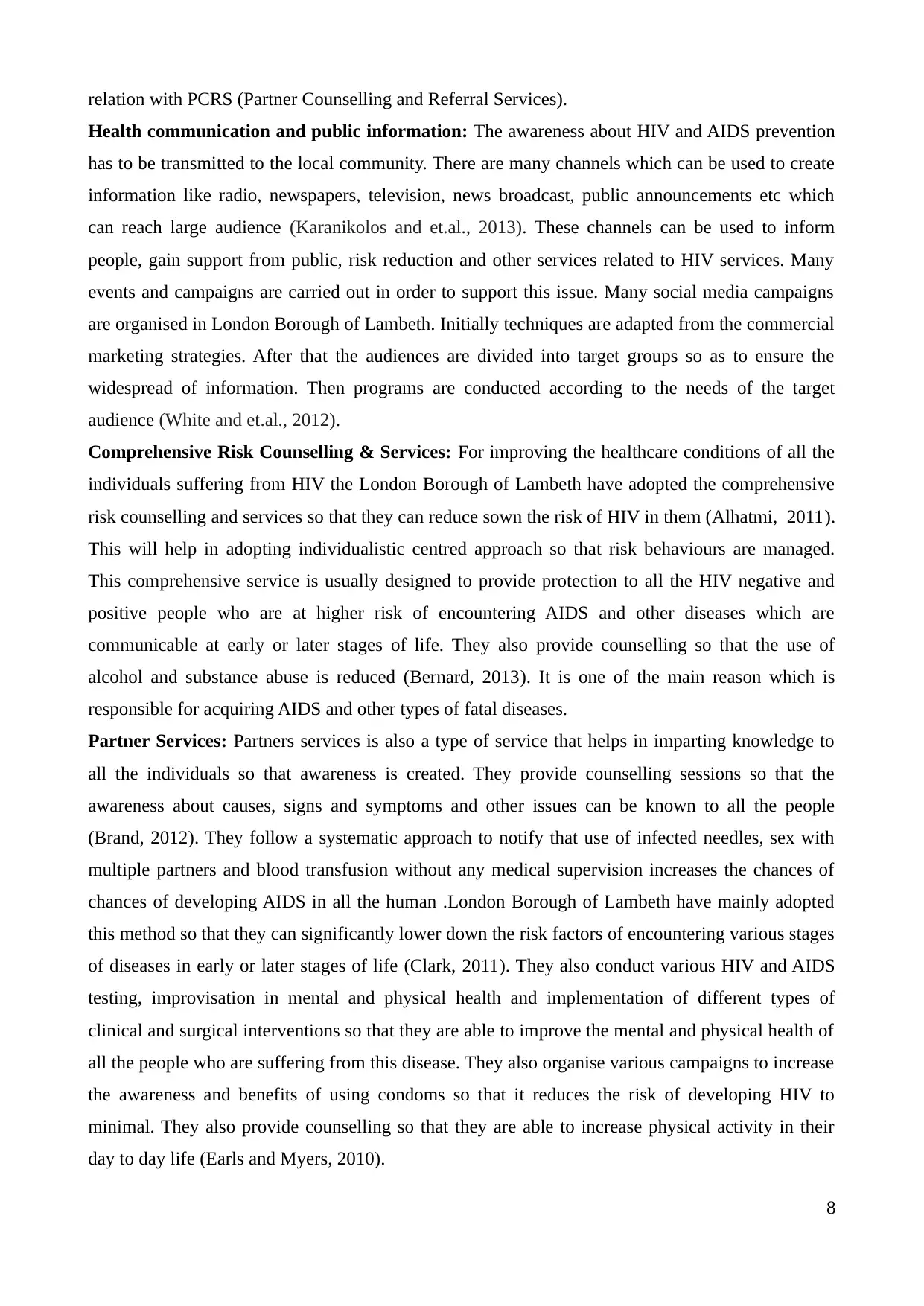
relation with PCRS (Partner Counselling and Referral Services).
Health communication and public information: The awareness about HIV and AIDS prevention
has to be transmitted to the local community. There are many channels which can be used to create
information like radio, newspapers, television, news broadcast, public announcements etc which
can reach large audience (Karanikolos and et.al., 2013). These channels can be used to inform
people, gain support from public, risk reduction and other services related to HIV services. Many
events and campaigns are carried out in order to support this issue. Many social media campaigns
are organised in London Borough of Lambeth. Initially techniques are adapted from the commercial
marketing strategies. After that the audiences are divided into target groups so as to ensure the
widespread of information. Then programs are conducted according to the needs of the target
audience (White and et.al., 2012).
Comprehensive Risk Counselling & Services: For improving the healthcare conditions of all the
individuals suffering from HIV the London Borough of Lambeth have adopted the comprehensive
risk counselling and services so that they can reduce sown the risk of HIV in them (Alhatmi, 2011).
This will help in adopting individualistic centred approach so that risk behaviours are managed.
This comprehensive service is usually designed to provide protection to all the HIV negative and
positive people who are at higher risk of encountering AIDS and other diseases which are
communicable at early or later stages of life. They also provide counselling so that the use of
alcohol and substance abuse is reduced (Bernard, 2013). It is one of the main reason which is
responsible for acquiring AIDS and other types of fatal diseases.
Partner Services: Partners services is also a type of service that helps in imparting knowledge to
all the individuals so that awareness is created. They provide counselling sessions so that the
awareness about causes, signs and symptoms and other issues can be known to all the people
(Brand, 2012). They follow a systematic approach to notify that use of infected needles, sex with
multiple partners and blood transfusion without any medical supervision increases the chances of
chances of developing AIDS in all the human .London Borough of Lambeth have mainly adopted
this method so that they can significantly lower down the risk factors of encountering various stages
of diseases in early or later stages of life (Clark, 2011). They also conduct various HIV and AIDS
testing, improvisation in mental and physical health and implementation of different types of
clinical and surgical interventions so that they are able to improve the mental and physical health of
all the people who are suffering from this disease. They also organise various campaigns to increase
the awareness and benefits of using condoms so that it reduces the risk of developing HIV to
minimal. They also provide counselling so that they are able to increase physical activity in their
day to day life (Earls and Myers, 2010).
8
Health communication and public information: The awareness about HIV and AIDS prevention
has to be transmitted to the local community. There are many channels which can be used to create
information like radio, newspapers, television, news broadcast, public announcements etc which
can reach large audience (Karanikolos and et.al., 2013). These channels can be used to inform
people, gain support from public, risk reduction and other services related to HIV services. Many
events and campaigns are carried out in order to support this issue. Many social media campaigns
are organised in London Borough of Lambeth. Initially techniques are adapted from the commercial
marketing strategies. After that the audiences are divided into target groups so as to ensure the
widespread of information. Then programs are conducted according to the needs of the target
audience (White and et.al., 2012).
Comprehensive Risk Counselling & Services: For improving the healthcare conditions of all the
individuals suffering from HIV the London Borough of Lambeth have adopted the comprehensive
risk counselling and services so that they can reduce sown the risk of HIV in them (Alhatmi, 2011).
This will help in adopting individualistic centred approach so that risk behaviours are managed.
This comprehensive service is usually designed to provide protection to all the HIV negative and
positive people who are at higher risk of encountering AIDS and other diseases which are
communicable at early or later stages of life. They also provide counselling so that the use of
alcohol and substance abuse is reduced (Bernard, 2013). It is one of the main reason which is
responsible for acquiring AIDS and other types of fatal diseases.
Partner Services: Partners services is also a type of service that helps in imparting knowledge to
all the individuals so that awareness is created. They provide counselling sessions so that the
awareness about causes, signs and symptoms and other issues can be known to all the people
(Brand, 2012). They follow a systematic approach to notify that use of infected needles, sex with
multiple partners and blood transfusion without any medical supervision increases the chances of
chances of developing AIDS in all the human .London Borough of Lambeth have mainly adopted
this method so that they can significantly lower down the risk factors of encountering various stages
of diseases in early or later stages of life (Clark, 2011). They also conduct various HIV and AIDS
testing, improvisation in mental and physical health and implementation of different types of
clinical and surgical interventions so that they are able to improve the mental and physical health of
all the people who are suffering from this disease. They also organise various campaigns to increase
the awareness and benefits of using condoms so that it reduces the risk of developing HIV to
minimal. They also provide counselling so that they are able to increase physical activity in their
day to day life (Earls and Myers, 2010).
8
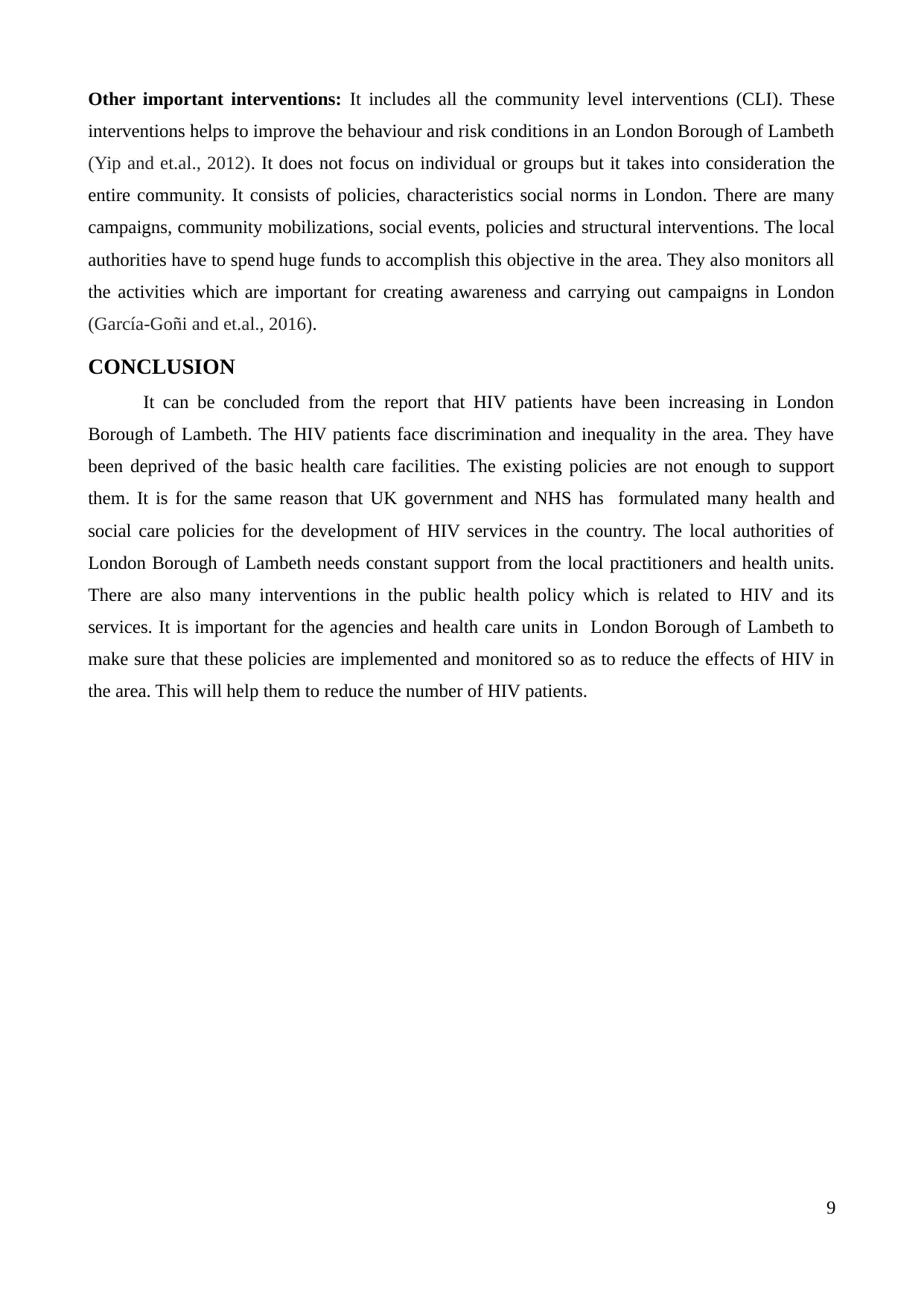
Other important interventions: It includes all the community level interventions (CLI). These
interventions helps to improve the behaviour and risk conditions in an London Borough of Lambeth
(Yip and et.al., 2012). It does not focus on individual or groups but it takes into consideration the
entire community. It consists of policies, characteristics social norms in London. There are many
campaigns, community mobilizations, social events, policies and structural interventions. The local
authorities have to spend huge funds to accomplish this objective in the area. They also monitors all
the activities which are important for creating awareness and carrying out campaigns in London
(García-Goñi and et.al., 2016).
CONCLUSION
It can be concluded from the report that HIV patients have been increasing in London
Borough of Lambeth. The HIV patients face discrimination and inequality in the area. They have
been deprived of the basic health care facilities. The existing policies are not enough to support
them. It is for the same reason that UK government and NHS has formulated many health and
social care policies for the development of HIV services in the country. The local authorities of
London Borough of Lambeth needs constant support from the local practitioners and health units.
There are also many interventions in the public health policy which is related to HIV and its
services. It is important for the agencies and health care units in London Borough of Lambeth to
make sure that these policies are implemented and monitored so as to reduce the effects of HIV in
the area. This will help them to reduce the number of HIV patients.
9
interventions helps to improve the behaviour and risk conditions in an London Borough of Lambeth
(Yip and et.al., 2012). It does not focus on individual or groups but it takes into consideration the
entire community. It consists of policies, characteristics social norms in London. There are many
campaigns, community mobilizations, social events, policies and structural interventions. The local
authorities have to spend huge funds to accomplish this objective in the area. They also monitors all
the activities which are important for creating awareness and carrying out campaigns in London
(García-Goñi and et.al., 2016).
CONCLUSION
It can be concluded from the report that HIV patients have been increasing in London
Borough of Lambeth. The HIV patients face discrimination and inequality in the area. They have
been deprived of the basic health care facilities. The existing policies are not enough to support
them. It is for the same reason that UK government and NHS has formulated many health and
social care policies for the development of HIV services in the country. The local authorities of
London Borough of Lambeth needs constant support from the local practitioners and health units.
There are also many interventions in the public health policy which is related to HIV and its
services. It is important for the agencies and health care units in London Borough of Lambeth to
make sure that these policies are implemented and monitored so as to reduce the effects of HIV in
the area. This will help them to reduce the number of HIV patients.
9
⊘ This is a preview!⊘
Do you want full access?
Subscribe today to unlock all pages.

Trusted by 1+ million students worldwide
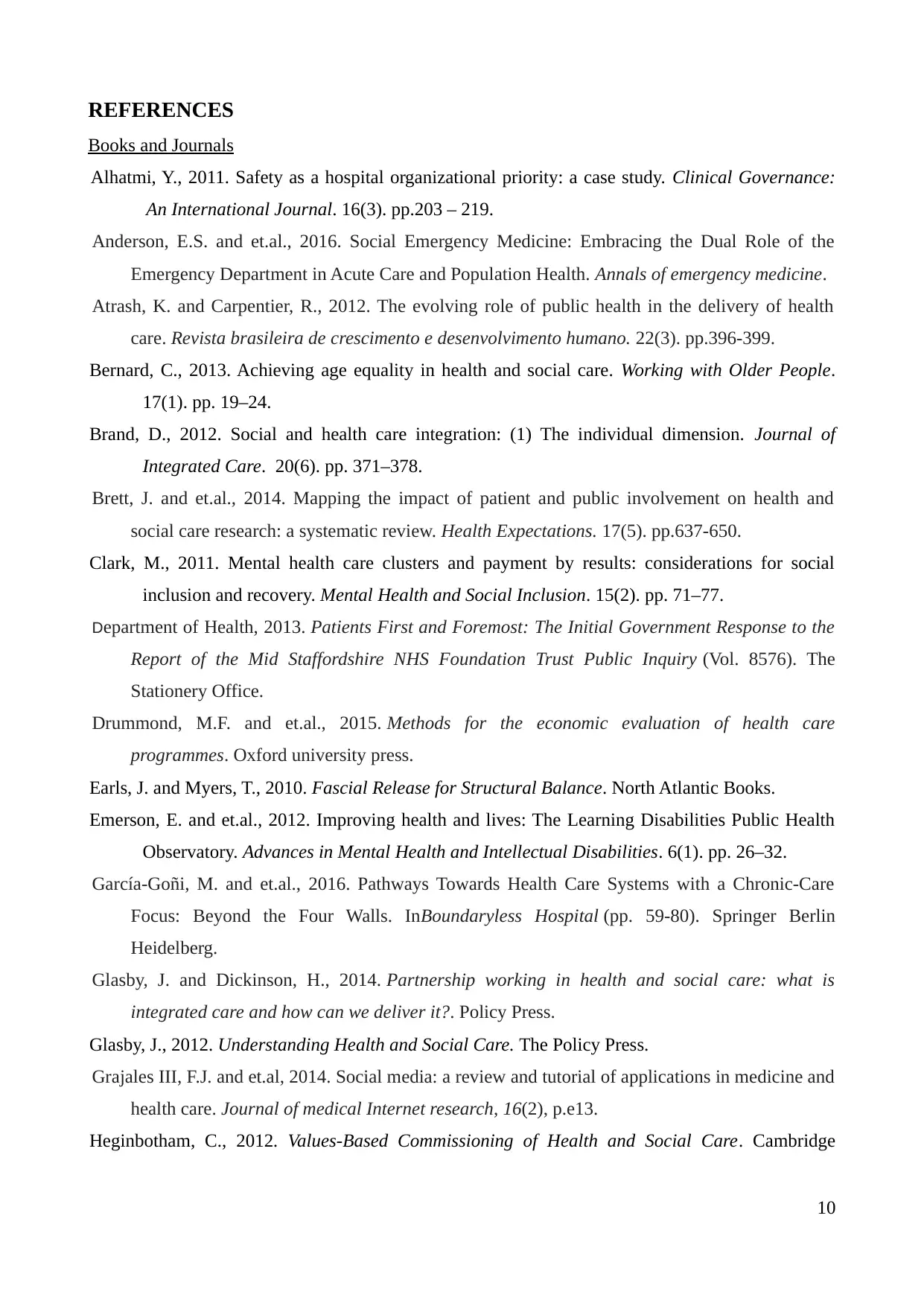
REFERENCES
Books and Journals
Alhatmi, Y., 2011. Safety as a hospital organizational priority: a case study. Clinical Governance:
An International Journal. 16(3). pp.203 – 219.
Anderson, E.S. and et.al., 2016. Social Emergency Medicine: Embracing the Dual Role of the
Emergency Department in Acute Care and Population Health. Annals of emergency medicine.
Atrash, K. and Carpentier, R., 2012. The evolving role of public health in the delivery of health
care. Revista brasileira de crescimento e desenvolvimento humano. 22(3). pp.396-399.
Bernard, C., 2013. Achieving age equality in health and social care. Working with Older People.
17(1). pp. 19–24.
Brand, D., 2012. Social and health care integration: (1) The individual dimension. Journal of
Integrated Care. 20(6). pp. 371–378.
Brett, J. and et.al., 2014. Mapping the impact of patient and public involvement on health and
social care research: a systematic review. Health Expectations. 17(5). pp.637-650.
Clark, M., 2011. Mental health care clusters and payment by results: considerations for social
inclusion and recovery. Mental Health and Social Inclusion. 15(2). pp. 71–77.
Department of Health, 2013. Patients First and Foremost: The Initial Government Response to the
Report of the Mid Staffordshire NHS Foundation Trust Public Inquiry (Vol. 8576). The
Stationery Office.
Drummond, M.F. and et.al., 2015. Methods for the economic evaluation of health care
programmes. Oxford university press.
Earls, J. and Myers, T., 2010. Fascial Release for Structural Balance. North Atlantic Books.
Emerson, E. and et.al., 2012. Improving health and lives: The Learning Disabilities Public Health
Observatory. Advances in Mental Health and Intellectual Disabilities. 6(1). pp. 26–32.
García-Goñi, M. and et.al., 2016. Pathways Towards Health Care Systems with a Chronic-Care
Focus: Beyond the Four Walls. InBoundaryless Hospital (pp. 59-80). Springer Berlin
Heidelberg.
Glasby, J. and Dickinson, H., 2014. Partnership working in health and social care: what is
integrated care and how can we deliver it?. Policy Press.
Glasby, J., 2012. Understanding Health and Social Care. The Policy Press.
Grajales III, F.J. and et.al, 2014. Social media: a review and tutorial of applications in medicine and
health care. Journal of medical Internet research, 16(2), p.e13.
Heginbotham, C., 2012. Values-Based Commissioning of Health and Social Care. Cambridge
10
Books and Journals
Alhatmi, Y., 2011. Safety as a hospital organizational priority: a case study. Clinical Governance:
An International Journal. 16(3). pp.203 – 219.
Anderson, E.S. and et.al., 2016. Social Emergency Medicine: Embracing the Dual Role of the
Emergency Department in Acute Care and Population Health. Annals of emergency medicine.
Atrash, K. and Carpentier, R., 2012. The evolving role of public health in the delivery of health
care. Revista brasileira de crescimento e desenvolvimento humano. 22(3). pp.396-399.
Bernard, C., 2013. Achieving age equality in health and social care. Working with Older People.
17(1). pp. 19–24.
Brand, D., 2012. Social and health care integration: (1) The individual dimension. Journal of
Integrated Care. 20(6). pp. 371–378.
Brett, J. and et.al., 2014. Mapping the impact of patient and public involvement on health and
social care research: a systematic review. Health Expectations. 17(5). pp.637-650.
Clark, M., 2011. Mental health care clusters and payment by results: considerations for social
inclusion and recovery. Mental Health and Social Inclusion. 15(2). pp. 71–77.
Department of Health, 2013. Patients First and Foremost: The Initial Government Response to the
Report of the Mid Staffordshire NHS Foundation Trust Public Inquiry (Vol. 8576). The
Stationery Office.
Drummond, M.F. and et.al., 2015. Methods for the economic evaluation of health care
programmes. Oxford university press.
Earls, J. and Myers, T., 2010. Fascial Release for Structural Balance. North Atlantic Books.
Emerson, E. and et.al., 2012. Improving health and lives: The Learning Disabilities Public Health
Observatory. Advances in Mental Health and Intellectual Disabilities. 6(1). pp. 26–32.
García-Goñi, M. and et.al., 2016. Pathways Towards Health Care Systems with a Chronic-Care
Focus: Beyond the Four Walls. InBoundaryless Hospital (pp. 59-80). Springer Berlin
Heidelberg.
Glasby, J. and Dickinson, H., 2014. Partnership working in health and social care: what is
integrated care and how can we deliver it?. Policy Press.
Glasby, J., 2012. Understanding Health and Social Care. The Policy Press.
Grajales III, F.J. and et.al, 2014. Social media: a review and tutorial of applications in medicine and
health care. Journal of medical Internet research, 16(2), p.e13.
Heginbotham, C., 2012. Values-Based Commissioning of Health and Social Care. Cambridge
10
Paraphrase This Document
Need a fresh take? Get an instant paraphrase of this document with our AI Paraphraser
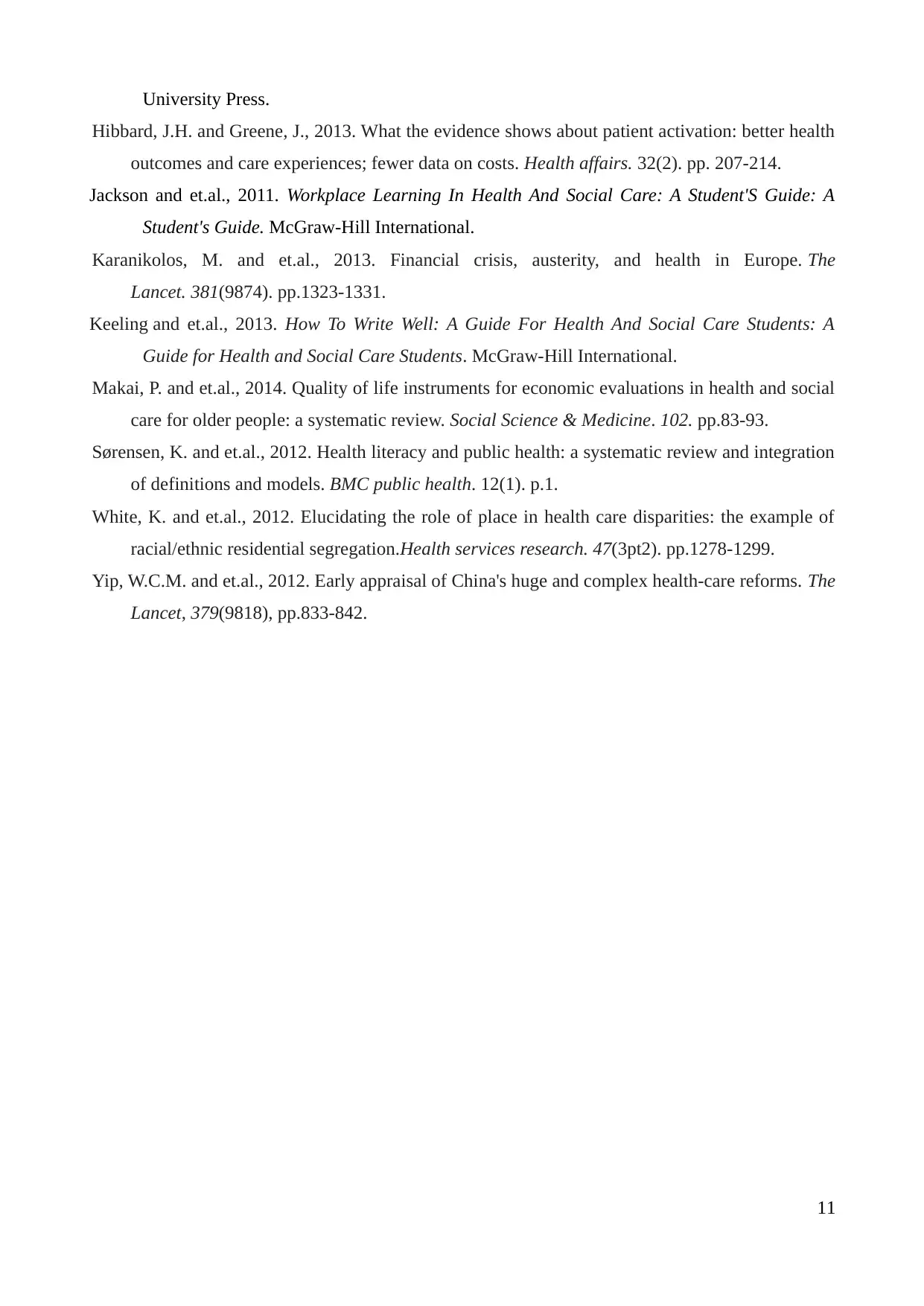
University Press.
Hibbard, J.H. and Greene, J., 2013. What the evidence shows about patient activation: better health
outcomes and care experiences; fewer data on costs. Health affairs. 32(2). pp. 207-214.
Jackson and et.al., 2011. Workplace Learning In Health And Social Care: A Student'S Guide: A
Student's Guide. McGraw-Hill International.
Karanikolos, M. and et.al., 2013. Financial crisis, austerity, and health in Europe. The
Lancet. 381(9874). pp.1323-1331.
Keeling and et.al., 2013. How To Write Well: A Guide For Health And Social Care Students: A
Guide for Health and Social Care Students. McGraw-Hill International.
Makai, P. and et.al., 2014. Quality of life instruments for economic evaluations in health and social
care for older people: a systematic review. Social Science & Medicine. 102. pp.83-93.
Sørensen, K. and et.al., 2012. Health literacy and public health: a systematic review and integration
of definitions and models. BMC public health. 12(1). p.1.
White, K. and et.al., 2012. Elucidating the role of place in health care disparities: the example of
racial/ethnic residential segregation.Health services research. 47(3pt2). pp.1278-1299.
Yip, W.C.M. and et.al., 2012. Early appraisal of China's huge and complex health-care reforms. The
Lancet, 379(9818), pp.833-842.
11
Hibbard, J.H. and Greene, J., 2013. What the evidence shows about patient activation: better health
outcomes and care experiences; fewer data on costs. Health affairs. 32(2). pp. 207-214.
Jackson and et.al., 2011. Workplace Learning In Health And Social Care: A Student'S Guide: A
Student's Guide. McGraw-Hill International.
Karanikolos, M. and et.al., 2013. Financial crisis, austerity, and health in Europe. The
Lancet. 381(9874). pp.1323-1331.
Keeling and et.al., 2013. How To Write Well: A Guide For Health And Social Care Students: A
Guide for Health and Social Care Students. McGraw-Hill International.
Makai, P. and et.al., 2014. Quality of life instruments for economic evaluations in health and social
care for older people: a systematic review. Social Science & Medicine. 102. pp.83-93.
Sørensen, K. and et.al., 2012. Health literacy and public health: a systematic review and integration
of definitions and models. BMC public health. 12(1). p.1.
White, K. and et.al., 2012. Elucidating the role of place in health care disparities: the example of
racial/ethnic residential segregation.Health services research. 47(3pt2). pp.1278-1299.
Yip, W.C.M. and et.al., 2012. Early appraisal of China's huge and complex health-care reforms. The
Lancet, 379(9818), pp.833-842.
11
1 out of 11
Related Documents
Your All-in-One AI-Powered Toolkit for Academic Success.
+13062052269
info@desklib.com
Available 24*7 on WhatsApp / Email
![[object Object]](/_next/static/media/star-bottom.7253800d.svg)
Unlock your academic potential
Copyright © 2020–2025 A2Z Services. All Rights Reserved. Developed and managed by ZUCOL.





